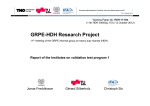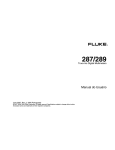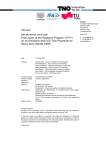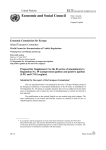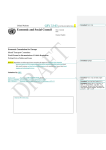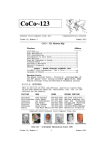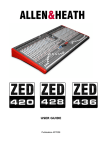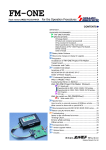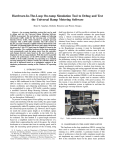Download HDH - unece
Transcript
Working Paper No. HDH-09-15 (9th HDH Meeting, 21 to 23 March 2012) Institute for Powertrains and Automotive Technology Getreidemarkt 9 A-1060 Wien http://www.ifa.tuwien.ac.at Univ.-Prof. Dipl.-Ing. Dr. Bernhard GERINGER Director tel.: +43-1/ 58801-31500 fax: +43-1/ 58801-31599 [email protected] GRPE INFORMAL GROUP ON HEAVY DUTY HYBRIDS REPORT OF INVESTIGATIONS ………………………………….. …………………………………………………….... Prof. Dr. B. Geringer Dr. Peter Hofmann …………………………………………………….... M.Sc. Michael Planer This report consists of 62 pages. March 2012 B 12012 INTRODUCTION Page 1 Directory 1. INTRODUCTION .................................................................................................. 2 1.1. BACKGROUND............................................................................................. 3 1.2. PREAMBLE TO THE WORK ........................................................................ 3 1.3. GLOBAL TASK OVERVIEW ......................................................................... 4 1.4. DETAILED TASK OVERVIEW OF IFA/TU VIENNA...................................... 6 2. The JAPANESE HILS METHOD .......................................................................... 9 2.1. CERTIFICATION OF HEAVY DUTY VEHICLES .......................................... 9 2.2. JAPANESE HILS CERTIFICATION METHOD ............................................ 10 2.2.1. HILS - HARDWARE ............................................................................. 15 2.2.1.1. JAPANESE METHOD ................................................................... 15 2.2.1.2. ASSESSMENT AND OUTLOOK FOR GLOBAL REGULATION .. 16 2.2.2. HILS - OPEN SOURCE SIMULATION MODEL ................................... 18 2.2.2.1. JAPANESE METHOD ................................................................... 18 2.2.2.1. ASSESSMENT AND OUTLOOK FOR GLOBAL REGULATION .. 25 2.2.3. HILS - COMPONENT TESTING .......................................................... 30 2.2.3.1. JAPANESE METHOD ................................................................... 30 2.2.3.1. ASSESSMENT AND OUTLOOK FOR GLOBAL REGULATION .. 35 2.2.4. HILS - MODEL VERIFICATION ........................................................... 36 2.2.4.1. JAPANESE METHOD ................................................................... 36 2.2.4.1. ASSESSMENT AND OUTLOOK FOR GLOBAL REGULATION .. 39 2.2.5. ALTERNATIVES TO JAPANESE HILS METHOD ............................... 40 2.2.5.1. PROPOSAL OF AN “EXTENDED HILS METHOD” ...................... 40 3. SUMMARY AND SUGGESTIONS ..................................................................... 43 4. TASKS FOR THE NEXT VALIDATION PHASE ................................................. 45 4.1. PREAMBLE TO WORK ............................................................................... 45 4.2. OVERVIEW ON THE QUOTED WORK ...................................................... 46 4.3. DESCRIPTION OF THE TASKS ................................................................. 47 TABLE OF FIGURES ................................................................................................ 53 REFERENCES .......................................................................................................... 55 APPENDIX ................................................................................................................ 56 March 2012 B 12012 INTRODUCTION Page 2 1. INTRODUCTION Due to current regulations, engine emission certification is done independent of vehicle use and application in given engine test cycles (speed / load tables). In order of a global usage, the new WHDC test cycles have been created covering typical driving conditions in the EU, USA, Japan and Australia. The WHVC (World Harmonised Vehicle Cycle) has been transformed by means of vehicle models and powertrain simulation into the WHTC (World Harmonised Transient Cycle) and WHSC (World Harmonised Stationary Cycle). The WHTC test is a transient engine dynamometer schedule defined by the proposed global technical regulation (GTR) developed by the UN ECE GRPE group. The GTR is covering a world-wide harmonized heavy-duty certification (WHDC) procedure for engine exhaust emissions. The proposed regulation is based on the world-wide pattern of real heavy commercial vehicle use. Two representative test cycles, a transient test cycle (WHTC) with both cold and hot start requirements and a hot start steady-state test cycle (WHSC), have been created covering typical driving conditions in the EU, USA, Japan and Australia. For certification actually the engines cycles are fixed by regulation for all applications in Europe and USA, whereas in Japan only the vehicle cycle represents a fixed basis. All these evaluations are based on current and conventional powertrain systems. In case of hybrid powertrain systems it can be expected, that –dependent of the type and layout of the hybrid- the real engine cycle might deviate strongly from today’s given engine test cycles. In order to a global regulation for heavy duty hybrids, an additional, specific certification method has to be used. Therefore a given already used Japanese certification method is taken in order to make an assessment of its possible basis for future global regulation. March 2012 B 12012 INTRODUCTION Page 3 1.1. BACKGROUND In Japan, the powertrain-layout is taken into account for the definition of the engine cycle. In accordance to that, a new system has to be developed for hybrid powertrains (Figure 1). Figure 1: Conventional- / HILS-Certification [5] Therefore JASIC and JARI developed a so called Hardware-in-the-Loop (HILS) approach. By using this HILS-simulation in combination of real vehicle validation and models for the different powertrain elements as well as vehicle and hybrid ECU, a new engine cycle is defined. This HILS approach is fully described [3]. A similar approach is in use for fuel economy and exhaust emission calculations and is described in Japanese regulation [2]. 1.2. PREAMBLE TO THE WORK Due to the Japanese certification method, the main goal of the project is to develop an emissions and CO2 test procedure for Heavy Duty Hybrids (HDH), which should be worldwide established. The test procedure should be based on the HILS (Hardware-in-the-Loop Simulation) method. As starting point the WHVC (World Harmonized Vehicle Cycle), the test cell environment, data evaluation procedures and emissions calculations specified in GTR (Global Technical Regulation) n°4 under the 1998 Global Agreement will be used. According to the informal document No. GRPE-60-11 the final procedure shall result in outputs that are quantifiable, verifiable, and reproducible and that provide a method for assessing real world compliance broadly and on a case by case basis, shall be capable of incorporating updated information and new data to produce the most accurate outputs, and shall March 2012 B 12012 INTRODUCTION Page 4 be appropriately transparent as to allow governmental entities the latitude to easily assess its performance and ensure accuracy and a level playing field. In a first step, the potential of HILS has to be investigated and described comprehensively to achieve a formalistic, cheap and simple method, which prevents manipulation and guarantees comparable result all over the world. 1.3. GLOBAL TASK OVERVIEW The whole investigation work is separated into 5 main tasks including their working packages. This topic gives a brief overview of all tasks including their covered topics. Task 1: ”Investigation and modification, if applicable, of the HILS model and interface” A detailed review of the Japanese HILS system and the open software An analysis of possible improvements and relevant gaps for a global regulation Workshops and/or smaller meetings with OEM’s and stakeholders to identify if all relevant input and output parameters from HDH-ECU’s are considered and if all hybrid architectures can be simulated. Elaboration of options to fill gaps if relevant. Analysis of the necessary preparation work and efforts to run a HILS system. Task 2: “Investigation and modification, if applicable, of the HILS component testing” A detailed review of the Japanese test procedure for obtaining HIL input parameter. An analysis of possible improvements and relevant gaps of the component testing. Improvements for future technological development. Task 3: “Extension of HILS to non-electrical hybrids which are currently not considered covered by Kokujikan No.281” Overview of possible other types of hybrids of interests and issues for HILS testing will be investigated. March 2012 B 12012 INTRODUCTION Page 5 Evaluation by using software models and simulation of the possibilities for using HILS for assessment of quality factors of these hybrids. Task 4: “Inclusion of PTO (Power Take Off) operation, which normally takes place outside the test cycle” Elaboration of options to simulate PTO power demand in conventional HDV and in HDH according to different vehicle categories and mission profiles Elaborate options to transfer the PTO related differences in engine work between conventional HDV and HDH into a benefit system within a HDH test procedure. Task 5: “Development of WHVC weighting/scaling factors to represent real world vehicle operation” Analysis of typical profiles for vehicle speed and propulsion power demand as well as of the corresponding engine load courses for representative driving cycles for conventional HDV according to different vehicle categories and mission profiles (data will be gained from the work performed together with ACEA on this topic in the actual process of developing a HDV CO2 certification procedure for DG Clima) Elaborate weighting factors for the different parts of the WHVC (urban, road, motorway, if necessary further splitting in sub-cycles) which result in similar profiles for vehicle speed and propulsion power as the representative driving cycles for each vehicle category and mission profile. Vehicle categorisation will follow the approach in the HDV CO2 certification procedure to establish compatible systems to enable efficient certification procedures. Elaborate option(s) to use the HILS method also in the HDV CO2 certification procedure for a possible future CO2 certification of hybrid HDVs. A possible option shall result in CO2 values comparable to the results gained with the HDV CO2 certification procedure designed for conventional HDV. Explanation: both, HILS and HDV CO2 certification, are based on similar simulation methods. In the HDV CO2 certification procedure however, the data of the actual vehicle model to be certified shall be considered while HILS uses rather generic data for vehicle categories. Since both procedures will result in specific CO2 values the overall effort for the certification of HDH (engine and possibly in future also the CO2 March 2012 B 12012 INTRODUCTION Page 6 emissions for the entire vehicle) can be minimised if both approaches are harmonised already during the development phase. These global tasks will be covered by following three Institutes: Institute for Powertrains and Automotive Technology (in following IFA/TU Vienna); Vienna University of Technology: Institute for Internal Combustion Engines and Thermodynamics; University of Technology Graz (in following TUG): Tasks 1 and 2 Tasks 4 and 5 Department of Signals and Systems, Mechatronics; Chalmers University of Technology: Task 3 1.4. DETAILED TASK OVERVIEW OF IFA/TU VIENNA The Institute for Powertrains and Automotive Technology is covering Tasks 1 and 2. Detailed information about the tasks and the included working packages are described in the upcoming topics. Task 1: Task 1 covers: “Investigation and modification, if applicable, of the HILS model and Interface and should include a proposal for a verification method w/o vehicle testing”. WP 1-1: Review of interface and software setup Initially it is to check the plausibility in form and content of the Japanese test procedure for exhaust emissions and consumption concerning different architectures of heavy duty electric hybrids, as given in “Kokujikan No. 281 of March 16, 2007”. Verifying the compatibility of the ECU with the input/output data structure in the Japanese HILS routine. Assessment of the open source-code depending on documentation and regarding accessibility and demand of extensibility. March 2012 B 12012 INTRODUCTION Page 7 WP 1-2: Analysis of improvements and relevant gaps for a global regulation Analysis of the hybrid architectures necessary to cover the engine packages worldwide and especially in Europe. Improving necessary HILS criteria to determine input data, like driving resistance, component temperature, including of cold start tests in the simulation tool to cover the EURO VI test procedure, and others. Appoint needs of adaptation for regional differences in vehicle designs. Analysis for a standard interface connecting the hardware (HDH ECU) with the HILS software. Identifying the working parameters of the ECU, to cover all necessary requirements of the different manufacturers now and in future. WP 1-3: Meetings with OEM’s and stakeholders Visiting Japan for a practical demonstration of the HILS measurement method, if secure. Investigation if all relevant input and output parameters of the hybrid architectures are considered, which are necessary to cover all engine packages worldwide and especially in Europe. This will be done in international Workshops and smaller informal meetings with the government authorities and heavy duty manufacturers. WP 1-4: Analysis of the necessary preparation work run a HILS system Analysis of the necessary preparation work and efforts to run a HILS system at IFA and/or TUG in a potential next phase of the project in the year 2012 to validate the approach suggested in the actual project with a HDH vehicle and its ECU. Task 2: Task 2 covers: “Investigation and modification, if applicable, of the HILS component testing” WP 2-1: Detailed review of the test procedure for obtaining HIL input parameter A detailed review of the test procedure for obtaining parameters of the engine, electric motor and electric storage device of Heavy-Duty Hybrid Electric Vehicles, which are to be inputted in the HILS system. Check of the plausibility of the Japanese method of obtaining input parameters concerning engine, electric motor and electric storage device, and the definition of their specific characteristic. March 2012 B 12012 INTRODUCTION Page 8 WP 2-2: Analysis of improvements and relevant gaps concerning component testing It is to verify if the Japanese component testing could be adopted for worldwide and European requirements. It is to determine, if all for worldwide regulations necessary parameters will be obtained within the Japanese component testing procedure. WP 2-3: Improvements for future technological development An analysis of necessary supplements for future hybrid-related components. Investigation, if the list of tested components could cover the future technological developments. March 2012 B 12012 THE JAPANESE HILS METHOD Page 9 2. THE JAPANESE HILS METHOD In the upcoming topics, the general certification of heavy duty vehicles will be described. The Japanese Method will be outlined in addition including IFA/TU Vienna’s assessment. 2.1. CERTIFICATION OF HEAVY DUTY VEHICLES Emission certification from conventional heavy-duty vehicles is normally done by operating the engine on a test bench. In this case, the engine is operated under predefined load and speed conditions. In order to recognise real vehicle operation for certification, a new certification procedure was developed by using a vehicle test cycle instead of an engine test cycle. This vehicle test cycle is resistant against an exchange of the powertrain technology like the introduction of hybrid technology, while an engine test cycle therefore has to be changed. This new test cycle, called “Worldwide Transient Vehicle Cycle” (WTVC) covers several different powertrains from 3.5 up to 40 tonnes and is derived from real vehicle use in Europe, Japan and the US. In order to use the WTVC cycle for certification a transformation into an engine test cycle, called “Worldwide Harmonised Transient Cycle” (WHTC) is necessary. The WHTC cycle is defined in terms of normalized engine speed and load, and is created by using a generic powertrain model. This normalized engine speed and load points are then scaled according to the characteristics of the engine that has to be certified (Figure 2). Figure 2: WTVC to WHTC transformation procedure [1] March 2012 B 12012 THE JAPANESE HILS METHOD Page 10 This approach basically could also be used for hybrid vehicles, but includes some problems. The main challenge is extra degree of freedom that hybrid's offer. The usage of an additional power source includes a higher dependency on the control system than conventional vehicles do. In this case the energy management strategy needs to be included. 2.2. JAPANESE HILS CERTIFICATION METHOD A possible test method for heavy duty hybrid electric vehicles (HEVs) is the usage of a Hardware-in-the-Loop simulator (HILS) which is fully described in Japanese Regulation Kokujikan No.281. [2] This Japanese method uses real hardware in case of the hybrid controller unit in combination with a generic powertrain model, Figure 3. This method is similar to the aforementioned conventional method shown in Figure 2. The basic idea is to simulate the powertrain in combination with a real controller which is recognised by using the Hardware-in-the-Loop approach. Figure 3: Outline of HILS System for Heavy-Duty Hybrid Electric Vehicle [2] The Japanese HILS system mainly consists of the HILS hardware, the software recognised HEV powertrain model for approval and its input parameters, the reference vehicle speed pattern, the hybrid ECU of the test motor vehicle (hereinafter referred to as the “actual ECU”) and its power supply (Figure 3). March 2012 B 12012 THE JAPANESE HILS METHOD Page 11 Energy management strategies are usually dependent on driving conditions. Therefore a driver model, which represents a real driver in order to command the vehicle according the vehicle test cycle, is also used. The results of the HIL system are the engine speed and loading conditions. These conditions are taken for engine certification on an engine test bench. Before this certification method can be used, conformity between real vehicle and simulation model has to be ensured. Therefore real vehicle data (detailed information about specific data can be found in 2.2.4) is compared to simulation results. Figure 4: Japanese HILS method for Heavy Duty Hybrid Vehicle Certification [5] Within the HEV simulation model, components are recognised by data maps or differential equations. If the resulting data from simulation is acceptable due to tolerances (2.2.4), HILS model results are used for certification. Therefore calculated engine speed and load profiles are taken as inputs for certification on a test bench (Figure 4). In order to confirm model quality prior to certification, an opportunity to use full simulation is given. The so called SILS (Software in the Loop) provides testing without using real hardware by using a simplified predetermined control algorithm (reference ECUmodel) instead of real hybrid ECU. This control algorithm is also used to make an assessment if used hardware is appropriate or not. Detailed information can be found in topic 2.2.1.1. The upcoming flow chart (Figure 5) shows an overview how HILS certification is done and is explained step by step. March 2012 B 12012 THE JAPANESE HILS METHOD Page 12 Step 1 Step 2 Step 3 Step 4 Step 5 Step 6 Step 7 Step 8 Step 9 Figure 5: Flow chart of HILS method March 2012 B 12012 THE JAPANESE HILS METHOD Page 13 The shown flow chart (Figure 5) can be explained in short terms as follows: Step 1: Start of the approval of test object. Step 2: Component specific data for engine, electric machines and energy storage according to the test procedures including vehicle mass, inertias, transmissions and gear ratios are generated and implemented within the simulation models. Step 3: In order to ensure that the system and component models are working well, pre-check is done by using SILS (Software in the Loop) -simulation. SILS is a simplified predetermined control algorithm. Step 4: Check if powertrain topology including their parameters has been certified before and analyse if additional verification is needed. If yes, system verification has to be done, otherwise go to step 6. Step 5: Verification is done either using a “system test bench” or on a chassis dynamometer. If the model represents the real vehicle, go to step 6, otherwise investigation on causes has to be done. Step 6: If verification process is passed, model parameters are used for running a full HIL-simulation. Step 6 includes an entire HIL-simulation run. Step 7: Check if vehicle follows the reference speed (predefined driving cycle) If yes, go to step 8, otherwise adjust vehicle driver and redo HIL-simulation Step 8: Check if energy level is within tolerances. If yes, go to step 9, otherwise adjust initial value of SOC and redo HILS-simulation Step 9: Fuel consumption is calculated from fuel consumption map. In order to do exhaust emission test, the engine load and speed profile obtained from the simulation are used on engine dynamometer. March 2012 B 12012 THE JAPANESE HILS METHOD Page 14 In other words the main idea of this method is to validate the system performance of the model against real data. Therefore the same acceleration and braking command signals are for real vehicle- and simulation model test. If the performance is close enough to a previously validated system, the powertrain system is assumed to be valid and type-approval of the vehicle can be performed. If the powertrain performance differs from a previously validated system, the complete system needs to be validated against chassis dynamometer tests or power pack tests. A number of tests for validation on system level are proposed. Japanese vehicles are specified in several categories (see Appendix). For each category the vehicle simulation model has to be validated. A more thorough presentation can be found in [2] and [3]. In order to make an assessment to this certification method, Japanese Automobile Research Institute (JARI) offered an open source model which represents a specific Japanese HEV-type model. Within this model SILS is used to keep the model running and in addition dummy data is used for all components due to confidential reasons. According to this open source model IFA makes its assessments. March 2012 B 12012 THE JAPANESE HILS METHOD Page 15 2.2.1. HILS - HARDWARE 2.2.1.1. JAPANESE METHOD As foreseen in a working package (WP 1-3), IFA visited Japan for a practical demonstration of the HILS measurement method. The investigation should point out if all relevant input and output parameters of the hybrid architectures are considered. In addition necessary signals, which have to be recognized according to the OEM’s for European and worldwide regulation, will be outlined. The presented Japanese HILS system at Japanese Automobile Research Institute (JARI) in Karima, Tsukuba, Ibaraki uses CRAMAS hardware from Fujitsu Ten in combination with SimAct software from Ono Sokki to run the system (Figure 6). CRAMAS stands for “ComputeR Aided Multi-Analyses System” and represents the developed HIL simulator for the Electronic Control Unit (ECU). For software modelling MATLAB® SIMULINK® program language is used as for setting up the model. CRAMAS hardware is able to handle several different signal types in order to set up an interaction between hardware and software. Data shifting between the software model and the hardware ECU can be done in real time. Figure 6: HILS-Hardware The complete list of all used signals for HILS method is attached as an appendix. The HILS method itself does not restrict the behaviour of DSP (Digital Signal Processor, hardware for HILS). However, it is necessary to verify whether the DSP is an appropriate hardware for the type approval test of HEV. Therefore, a testing method to verify the calculation performance within the DSP using the SILS model was developed. In this test, the calculation results by SILS of basic system are March 2012 B 12012 THE JAPANESE HILS METHOD Page 16 regarded as standard, and compared the results of DSP to be used. The calculation performance of the DSP hardware is sufficient for the type approval test and will therefore be checked. Following Figure 7 shows an overview of SILS test. Figure 7: SILS-Testing [5] 2.2.1.2. ASSESSMENT AND OUTLOOK FOR GLOBAL REGULATION Generally Japanese hardware and software like presented is a promising configuration basis in order to a global regulation method. Detailed information of the CRAMAS hardware is limited because of its high grade of novelty.[4] Therefore assessment is done on available data. A detailed specification of needed hardware has to be named in future tasks. In general, HILS hardware at least has to be able to handle with “AD/IO, PULSE, LVDS, LAN and CAN” -signal types. Sufficient for constructing the interface between the HILS hardware and the actual ECU are a certain number of provided channels. Those channels have to be checked and calibrated in order to provide high accuracy. Real time capability must be ensured. This can be done by using the aforementioned SILS opportunity in order to test the DSP and its hardware components. IFA’s assessment to the software of the demonstrated HILS system is made in Chapter 2.2.2. March 2012 B 12012 THE JAPANESE HILS METHOD Page 17 IFA presented this Japanese HILS approach to manufacturers and OEMs in order to get information about their opinion. According to the OEM’s, following signals also have to be recognized within the HILS method and have to be added to actual used signal list in chapter appendix, page 60: Table 1: Manufacturer required signals Model SignalSpecification Designation RESS Temperature Temperature data of power electronics Engine/Generator Temperature Temperature data of power electronics Combustion Engine Temperature Environment Temperature Air temperature Exhaust temperature (at multiple locations) Coolant temperature Oil temperature Intake temperature The HILS hardware has to be able to handle the transfer of these mentioned signals between software model and ECU. Possible signal types, which are not covered at the moment and not mentioned by manufacturer during meetings, have to be added in future. Therefore the used system must provide capability of expansion with low effort. March 2012 B 12012 THE JAPANESE HILS METHOD Page 18 2.2.2. HILS - OPEN SOURCE SIMULATION MODEL 2.2.2.1. JAPANESE METHOD The Japanese simulation model is realized with MATLAB® SIMULINK®, which based on physical models (numerical solving of differential equations) and lookup tables. As mentioned the Japanese HILS-System consists of real hardware in combination with software components. Figure 8 shows the schematic topology of the Japanese simulation model. Figure 8: Schematic Model Topology The whole system is based on a so called Hardware in the Loop simulation. In order to close the open loop of System components which are represented by a software model, real hardware is used. Within The Japanese HILS concept only the ECU is represented by real hardware. All other components are recognised by software model. The present simulation model consists of two main parts: Interface Model Powertrain Model March 2012 B 12012 THE JAPANESE HILS METHOD Page 19 Interface Model: The Interface Model is mainly responsible for the data shifting between real hardware and simulated hardware (software) components. A part of its tasks is to provide time dependant values as inputs or outputs. These values are allocated by external Hardware, in case of certification a real hardware ECU. In order to do some pre checks for simulation possibility of using software modelled ECU is also given. Therefore the so called “HILS/SILS-switch” is used and responsible for defining whether real hardware or software should close the loop for simulation. In order to make an assessment of the Japanese HILS certification method, a simplified software ECU is used. The interface model also serves the purpose of converting physical quantities of ECU electric signals in order to feed the open source model calculations. In order to prevent vehicle fail, dummy data or signals are generated within the interface model. IFA didn’t have access to a real interface model due to confidentiality. Therefore the assessment of interface model is only done on open source model. Within the Japanese open source model the SILS option is used. This makes IFA’s investigations without using real hardware possible. The highlighted Simulink® blocks in Figure 9 represent the interface model. The SILS-ECU and the aforementioned HILS/SILS switch is also reflected within this figure. Figure 9: Simulink® Model Topology March 2012 B 12012 THE JAPANESE HILS METHOD Page 20 Powertrain Model: The second main part is the powertrain model. The yellow marked block in Figure 9 represents the powertrain topology of the HEV and includes all remaining powertrain components (see upcomming topics). In Japan, five different types of powertrains, four parallel and one serial soncept, exist and each one has its own model (Figure 10). Figure 10: Hybrid Vehicles in Japanese Market [5] The investigated open source model represents a heavy duty vehicle with parallel hybrid topology. The Japanese standard powertrain model combines four main components: Combustion Engine Unit Motor/Generator Unit Energy Storage Unit Drive Unit Figure 11 shows the arrangement and integration of the aforementioned Units within the Simulink® model. March 2012 B 12012 THE JAPANESE HILS METHOD Page 21 Figure 11: Simulink Submodel Arrangement Combustion Engine Unit The Combustion Engine Unit considers the engine torque limits, ASR functionality, engine torque losses and the engine dynamic behaviour. The engine model calculates the generated torque of the engine from the engine torque command value, throttle valve opening angle or injection amount command value and the torque map in relation to the revolution speed. The torque generated by the engine, the starter torque and the torque loaded on the engine from outside, are combined. The revolution speed is determined from the combined torque and the inertia moment of the engine’s rotating sections. If the actual ECU requires a revolution control or revolution limit, the PID control function inside the engine model controls the engine revolution speed. In addition, the idle revolution speed can be adjusted by the input for adjustment (Figure 12). Figure 12: Conceptual Diagram of Engine Model [2] March 2012 B 12012 THE JAPANESE HILS METHOD Page 22 Motor/Generator Unit The Motor/Generator Unit is responsible for the consideration of Motor/Generator torque limits, ASR functionality, Motor/Generator losses, Motor/Generator dynamic behaviour and the Motor/Generator electric energy conversion. The resulting value is the electric current. The electric motor model has the voltage as its parameter. It has the torque map and the electric power consumption map in relation to the electric motor torque command value and the revolution speed. While driving or controlling the vehicle based on the electric motor command value inputted from the actual ECU, it calculates electric power consumption. The electric motor torque command value corresponds to the switching of power running / regeneration (Figure 13). Figure 13: Conceptual Diagram of Electric Motor Model [2] Energy Storage Unit Within this unit either a battery or a capacitor can be represented by using an internal switch. It considers the internal resistance for charging and recharging. The State of Charge will be the resulting value. The charged / discharged power and the state of a charge of the nickel metal hydride battery or lithium-ion battery shall be calculated by using the following formulas: In this case, the state of charge shall be calculated by current integration assuming that the Coulomb efficiency is 100 %. Both the open voltage and internal resistance of the battery shall be calculated from the map in relation to the state of charge, since they change according to the state of charge (Figure 14). March 2012 B 12012 THE JAPANESE HILS METHOD Page 23 ∙ P Vs % I Vo Ri ∙ ∙ ∙ 3600 ∙ 100 :Charged/dischargedpower W :Terminalvoltage V SOC SOCinitial :Stateofcharge % : Initial state of charge :Electriccurrent A :Openvoltage V :Internalresistance Ω Cnominal t :Ratedcapacity Ah :Elapsedtime s Figure 14: Conceptual Diagram of Battery/Capacitor Model [2] Drive Unit The Drive Unit is responsible for the consideration of the driving resistance, the transmission including friction losses and the clutch. Therefore the output will be the vehicle speed and the engine and gearbox speeds. The vehicle / power train system model consists of the running resistance model, the transmission / vehicle model and the clutch for electric motor model. This not only calculates the running resistance but also gives and receives the torque between the engine model and the electric motor model, generating the vehicle speed. March 2012 B 12012 THE JAPANESE HILS METHOD Page 24 Running resistance model This model calculates the running resistance from the vehicles speed, using the following formula: μ ∙ ∙ ∙ ∙ sin μ R :Runningresistance N μr :Rollingresistancecoef. kg/kg m :Vehiclemassattimeoftest kg V :Vehiclespeed km/h g :Accelerationofgravity m/s2 θ :Longitudinalgradient rad μaA :Airresistancecoefficient frontalprojectedarea kg/ km/h 2 Here,theaccelerationofgravityisassumedtobe9.80665 m/s2 . Transmission • vehicle model This model calculates the torque transmitted to the vehicle from the engine torque, electric motor torque, reduction ratio at each speed, final reduction ratio, gear efficiency and inertia moment of each component. From this torque and the load torque consisting of the running resistance of the vehicle, vehicle mass, inertia moment of the tires and axles, the acceleration of the vehicle can be determined. The torque transmitted from the transmission input shaft to its output shaft is calculated from the clutch stroke and gear transmission efficiency, and inertia moment is set for each speed. Clutch model This model simulates the clutch operation between the engine and transmission, and calculates the transmission (including the electric motor) / input shaft revolution speed, and the load torque to the engine. It adds the torque inputted from the electric motor and calculates the input shaft revolution speed from the inertia of the clutch section including the electric motor. March 2012 B 12012 THE JAPANESE HILS METHOD Page 25 2.2.2.1. ASSESSMENT AND OUTLOOK FOR GLOBAL REGULATION In order to make an assessment to the simulation model without using real hardware, JARI offered a so called open source model which can be operated in completely with software. It is a kind of SILS-model where the ECU is represented by a simplified predetermined control algorithm. In general the open source model is divided into several blocks, which makes it easier to set up such kind of comprehensive simulations. Therefore all functions, maps or data which represent one compound of the powertrain are combined to an extra block called submodel. This kind of submodel-programming provides good overview of complete simulation model and prevents from losing track. Another advantage of using submodels is the ability to exchange full blocks, if components should be replaced. The Japanese open source HILS model is realised with Simulink®, a well-established programming language, and doesn’t have to be changed in future. The model depth of component characterisation depends on the given tolerances (see 2.2.4). If the results are not accurate enough, the submodel has to be enhanced by updating either the used specific functions and differential equations or the used characteristic maps. For detailed information about providing characteristic maps, please see 2.2.3 component tests. Generally the simulation model (assessment based on open source model) provides a good basis for global regulation. In order to a worldwide test procedure additional work has to be done and will be outlined in following topic. Discussion about model and method enhancements: Powertrain concepts: According to the Japanese HILS certification method, there are only five different types of powertrains available. In order to include more types of powertrains, including non electric hybrid concepts, have to be implemented. March 2012 B 12012 THE JAPANESE HILS METHOD Page 26 Component modelling: In order to set up a hybrid powertrain model, numerical solving of specific differential equations and maps are used within the Japanese method for representing each component. In order to a global regulation future components have to be added. A promising concept will be a component library. This makes it possible to choose the right component out of a list and only characteristic data have to be inserted as maps. Certification with hot and cold start: The Japanese HILS certification is only done in warm condition. Due to the European certification, cold start also has to be recognised. Durability: The Japanese HILS model only recognises “healthy” components. This means that there is no durability of the components recognised within the simulation model. The implementation of aging models has therefore to be discussed. Thermal modelling: The hybrid electric powertrain is the combination of two propulsion systems in order to achieve either better fuel economy than a conventional vehicle, or better performance. In the present case a conventional internal combustion engine (ICE) propulsion system cooperates with an electric propulsion system. In order to use right operation strategy (pure electric driving, load point shifting …) the hybrid ECU needs specific data from certain components. According to manufacturer’s opinion temperature signals have to be provided and recognised within the simulation model in order to feed the ECU with data. The Japanese HILS model does not cover temperature signals and has therefore be enhanced. (ECU needed temperature signals are shown in Table 1 in 2.2.1.2) Auxiliaries The hybrid powertrain provides the possibility of using some auxiliaries more efficiently by electrification of some components or even electrified control. Due to actual certification methods, no auxiliaries are recognised for emission certification, but for a global regulation discussion on this topic has to be made. March 2012 B 12012 THE JAPANESE HILS METHOD Page 27 Centralised ECU The Japanese HILS model uses a centralised hybrid engine control unit. According to European manufacturers, several different control units are used. The control units are divided the functionality into several units while Japanese control units are dedicated to one task. In order to a global regulation, HILS certification model has to be able to handle more than one control unit. To adapt the Japanese method for European needs, the ability of using a decentralised (more than one ECU) control unit has to be included. Interface Model Within the Japanese HILS method, manufacturers build up their own Interface Models (Figure 15). Therefore each manufacturer has its own ECU Input/Output signal specifications, CAN Bus configuration/codes and is able to use its own control unit environment because all these signals are usually nondisclosed. In a worldwide regulation, it is expected that the Interface Models will be developed by the manufacturers due to confidentiality. In accordance to manufacturers opinion, several signals must be added or have to be provided within the Interface Model for the hybrid ECU. In our research, we did not have access to an interface model due to confidentiality. But the information about input and output signals within the interface model is available in Japanese regulation [2]. Each manufacturer has to be allowed to create his own interface model to connect the Control Units because it is not possible to use a standard interface for different control units. The Interface Model has to be able to handle time dependent input signals from the ECU and output signals from the Powertrain Model. It has to be modelled by the manufacturer because of recognising special signals (temperature, etc.). It is mandatory to verify the accuracy of HILS result by comparing with actual HEV test result for verifying the interface model. So it is impossible to create illegally interface model. In general, modelling of specific abilities of real hardware is a very complex task and sometimes combined with high effort. Due to that, consequences for simulation results (signal values, OBD …), in cases of incorrect or inaccurate signals/results, have to be named including needed arrangements. March 2012 B 12012 THE JAPANESE HILS METHOD Page 28 Figure 15: Interface Model [5] Discussion on open source HILS model JARI offered an open source model to make an assessment on the HILS model. Therefore dummy data are used for component characteristics and a simplified control strategy is used as SILS-ECU. 1. Due to that, the model only represents one of the five topologies. In order to make a more detailed assessment, dummy data have to be replaced by real data and further investigations have to be done. The future working tasks for the next verification phase are named in chapter no 4. 2. The aforementioned driver model (chapter 2.2) is not recognised within open source SILS model. Generally the driver model is responsible for the HEV model in order to achieve the reference vehicle speed (torque demand) by generating accelerator, brake and shift signals. This can be done by using PID control or by replacing the driver model by data of accelerator, brake, shift signals or torque demand in certain cases inside the interface model. 3. IFA/TU Vienna made investigations on setting up a power dependant certification cycle with the WHTC as basis instead of the WHTC speed cycle. Detailed information on these investigations will be reported by TU Graz. Regardless of detailed information on the suggestion of replacing the speed dependant cycle with a power dependant one, the driver model has to be enhanced upon its targets. March 2012 B 12012 THE JAPANESE HILS METHOD Page 29 4. As mentioned in 2.2.1.2 additional signals have to be provided in hardware and software. Therefore the present open source model outputs have to be modified as well as the hardware control unit outputs to fit the signal requirements of the model and hardware inputs, like temperature signals. March 2012 B 12012 THE JAPANESE HILS METHOD Page 30 2.2.3. HILS - COMPONENT TESTING 2.2.3.1. JAPANESE METHOD The components of the heavy duty hybrid powertrain are recognised by physical models (numerical solving of differential equations) and lookup tables within the Japanese HILS simulation model. In order to feed physical models with component specific data, special test procedures are used. These component characteristic data are combined to so called maps, which are used in software models (see aforementioned topics in 2.2.2). The specific test procedures are shown in the upcoming Figures. Test Procedure for Engine Torque Characteristics • Fuel Economy Map for HILS System Figure 16: Engine Test Procedure [2] March 2012 B 12012 THE JAPANESE HILS METHOD Page 31 Test Procedure for Electric Motor Torque; Electric Power Consumption Characteristics for HILS System Figure 17: Electric Motor Test Procedure [2] March 2012 B 12012 THE JAPANESE HILS METHOD Page 32 Test Procedure for Internal resistance • Open Voltage of Ni–MH / Li–ion Battery for HILS System Figure 18: Battery Test Procedure [2] March 2012 B 12012 THE JAPANESE HILS METHOD Page 33 Test Procedure for Fuel Consumption Rate of Heavy-Duty Hybrid Electric Vehicles Figure 19: Test Procedure for Fuel Consumption Rate [2] March 2012 B 12012 THE JAPANESE HILS METHOD Page 34 Verification Test Procedure for HILS System for Heavy-Duty Hybrid Electric Vehicles Figure 20: Verification Test Procedure [2] The exact component test procedure for HILS certification can be found in Japanese regulation [2]. Within this testing procedure each component which is recognised within the simulation model, has to run through specific tests in order to provide characteristic data. March 2012 B 12012 THE JAPANESE HILS METHOD Page 35 2.2.3.1. ASSESSMENT AND OUTLOOK FOR GLOBAL REGULATION In general, the used component test procedures are well defined in order to provide data for simulation model. The aforementioned test procedures are common test procedures and seem to can be adapted to global regulation. The simulation data have to be adequate accurate in order to fulfil the fixed tolerances. Due to future components, like non electric hybrids, new test procedures have to be defined. In other words, any powertrain simulation model is allowed, as long as the verification test is passed. If the verification test cannot be passed, obviously the component simulation model, including its component test procedures, has to be improved. As already mentioned, additional needed temperature signals have to be provided within the simulation model. The testing effort in order to provide specific data for components is dependent on the need of accuracy for these signals. If there is a demand of high accuracy on e.g. the combustion engine temperature data signals, a high testing effort will to be expected. In cases of too high testing effort IFA/TU Vienna suggestion is to use an “Extended HILS” method. This suggestion is an expansion of the Japanese HILS method. The Extended HILS method uses the advantages of the “Hardware in the Loop System” by recognising another real hardware component, in addition to the ECU. This suggestion will be described in more detail in the upcoming chapter 2.2.5. March 2012 B 12012 THE JAPANESE HILS METHOD Page 36 2.2.4. HILS - MODEL VERIFICATION 2.2.4.1. JAPANESE METHOD As shown in Figure 5, simulation model has to be verified to provide the reproducibility for the behaviour of the actual vehicle (chassis dynamometer) or system (system test bench). Therefore following two verifications methods were used. 1. Verification of correlation within a short-period vehicle operation Within this first verification test, the first 120 seconds of Japanese JE05 test cycle are taken for a small trip. Within this short period, start-acceleration-gearshiftdeceleration-stop operations are recognised. Figure 21: 1st Step of HILS Verification Test This verification clarifies whether the model reproduces the behaviour of each hybrid segment by using the actual accelerating/braking pedal signals as input into HILS. The correlation between the HILS calculation results and the actual vehicle (or system) operation are examined for the following items. 1) Vehicle speed or engine rpm 2) Torque and power of the electric motor 3) Torque and power of the engine 4) Power of RESS March 2012 B 12012 THE JAPANESE HILS METHOD Page 37 Good correlation is demonstrated by confirmation of tolerances. The table below shows an example of maximum allowed tolerances within the short-term verification test. Table 2: Table of tolerances for 1st Step of HILS Verification Test [2] Figure 22: Comparison for 1st Step of HILS Verification Test Correlation coefficients for each variable (e.g. MG Torque or RESS power) are calculated and have to be larger than the specific tolerance value. If these conditions are fulfilled, next verification step will be done. Otherwise the simulation model has to be improved. March 2012 B 12012 THE JAPANESE HILS METHOD Page 38 2. Verification of correlation for the load and fuel efficiency of whole test cycle In order to check whether the HILS calculation reproduces the actual vehicle (or system) throughout the long-period operation cycle, total engine work and fuel consumption including several patterns of acceleration, deceleration are verified. Figure 23: 2nd Step of HILS Verification Test If these aforementioned verifications steps are passed and results are within tolerances (Table 3), the simulation model is used for an entire HILS run (Step 6 in Figure 5) Table 3: Table of tolerances for 2nd Step of HILS Verification Test [2] Figure 24: Comparison for 2nd Step of HILS Verification Test [5] March 2012 B 12012 THE JAPANESE HILS METHOD Page 39 2.2.4.1. ASSESSMENT AND OUTLOOK FOR GLOBAL REGULATION The Japanese verification test as described in regulations [2] is separated in two steps. The first step is used to confirm the accuracy behaviour of each hybrid segment. Therefore vehicle speed or engine rpm, torque and power of the electric motor, torque and power of the engine and power of RESS are compared to those of real measured vehicle data. To avoid a cumulative error, comparison is done for a short period of the Japanese speed cycle. If results are within tolerances, the second test (long term verification test) is done by comparison of simulated data with real measure data due to Table 3. If all results are within tolerances, the simulation model is suitable for HILS certification run. This Japanese simulation model verification process is a promising method for comparison but has to be modified slightly in a first step. Therefore the driving cycle has to be changed to a specific and later to a worldwide cycle. Japanese tolerances can be used but have to be discussed in detail to be appropriate for global regulation by GTR. March 2012 B 12012 THE JAPANESE HILS METHOD Page 40 2.2.5. ALTERNATIVES TO JAPANESE HILS METHOD 2.2.5.1. PROPOSAL OF AN “EXTENDED HILS METHOD” The Japanese HILS method is based on a combination of hardware ECU and software modelled heavy duty hybrid powertrain. In order to provide characteristic data for software modelled components specific component test procedures are used (see 2.2.3). According to OEM’s, additional signals have to be recognised within the model. This would result in an increased effort in component testing procedure. A promising enhancement of the Japanese HILS model is the proposal of an “Extended HILS Method” which uses the advantages of the “Hardware in the Loop System” by implementing another real hardware component in addition to the ECU. The most required signals, mentioned by OEM’s, are temperature signals of the combustion engine which have to be provided as inputs for ECU. According to this, the combustion engine is recognised as real hardware within following proposal. Japanese HILS method is done in 3 main steps. The “Extended HILS Method” is a kind of fusion of Step 2 and Step 3 (Figure 25). Figure 25: Proposal of an “Extended HILS Method” March 2012 B 12012 THE JAPANESE HILS METHOD Page 41 Japanese HILS method uses the resulting engine speed and load profiles of step 2 as test bench inputs for step 3 whereas in Extended HILS Method the two aforementioned steps are done at once. Function Principle (Figure 26): The Interaction of the real engine with the virtual remaining powertrain takes place through defined interfaces. This will be done through similar or same hardware interfaces as done in Japanese HILS. On the mechanical level, the separation is made between the crankshaft of the real engine and the virtual clutch. The connection is established by measuring the torque at the torque sensing flange on the test bed and feeding this signal into the simulation's virtual engine flange. At the same time, the calculated speed of the virtual engine flange is transmitted as a command input to the test bed dynamometer Figure 26: “Extended HILS Method” March 2012 B 12012 THE JAPANESE HILS METHOD Page 42 Control Principle: 1) With a given throttle position, the engine provides a certain torque, which is measured by means of the torque sensing flange (“Mmeasured”) and transferred to the simulation model, where it acts on the virtual engine flange. 2) This acting torque in the vehicle works against the driving resistances. In the steady-state case, the torque exactly equals the driving resistances, so the vehicle is driving at a constant speed. 3) This vehicle speed is translated to an actual desired engine speed (“ndesired”) considering the present gearbox ratio. The desired engine speed is transmitted to the dynamometer, in order to make the real engine work at the same speed as it would do in the vehicle. 4) With the driver increasing throttle position, a higher torque value will be measured at the torque sensing flange. This higher torque in the simulation model will cause vehicle acceleration and thus an increasing “ndesired” for the dynamometer and the real engine. 5) For the correct reproduction of the dynamic behavior of the combustion engine, the speed of the dynamometer control and stability are essential. Advantages: • Already available test bench is combined with simulation model • Data of specific signals can directly be used by ECU • • no need of simulation with complex compound testing effort Model required signals and data are shifted to the simulation model via the hardware interface (as done with ECU signals in Japanese Method) • Measurements of real consumption and exhaust emission rates are done at once • No falsified hybrid strategy because of real ECU data input This proposal is also called “Engine in the Loop” System. A very similar System to this proposal has been successfully applied at TU Vienna/IFA [6,7]. March 2012 B 12012 SUMMARY AND SUGGESTIONS Page 43 3. SUMMARY AND SUGGESTIONS In order to make certification on heavy duty hybrid vehicles, actual used method for certification of conventional heavy duty vehicles has to be enhanced. A certification method for heavy duty hybrid vehicles already exists in Japan. The task of IFA/TU Vienna in this project was to make an assessment of the used Japanese certification method in regard to a global regulation. In addition to Japanese regulation information, an open source model was provided by Japanese institute (JARI) in order to make assessment on simulation model. For the Japanese HILS certification, five types of hybrid electric vehicles are considered (four parallel, one serial hybrid) within powertrain models. The five topologies and parameters (including battery type) are inspired by actual vehicles on the Japanese Market. The simulation model is realized with MATLAB® SIMULINK®, a well-established programming language, which is based on physical models and lookup tables. The model mainly consists of the powertrain and the interface model. The powertrain model is representative for combustion engine unit, motor/generator unit, energy storage unit and drive unit. The interface model is responsible for time dependent input values of the hybrid control unit. The purpose of the interface model is to convert physical quantities of ECU electric signals to fit on the open source model calculations, to generate dummy signals if necessary, to prevent vehicle fail and to convert ECU signals for calculations if needed. In addition, a driver model is used to create the necessary pedal position as an input to the ECU and the hybrid control unit. For the HILS verification, the test is separated in two steps. The first step is used for confirmation of the consistency between the HEV system and each model and the second step to confirm the quality of the vehicle model. Thereby the results of the simulation model are validated by available measurement data. If the performance is close enough to a previously validated system, the powertrain system is assumed to be valid and type-approval of the vehicle can be performed. If the powertrain performance differs from a previously validated system, the complete system needs to be validated against chassis dynamometer tests or power pack tests. Generally the Japanese HILS certification is very promising method for certification of heavy duty hybrids. In order to set up a global regulation by using the Japanese method as a basis, modifications/enhancements have to be done. March 2012 B 12012 SUMMARY AND SUGGESTIONS Page 44 According to IFA/TU Vienna and OEMs more powertrain topologies have to be implemented. Therefore the model including verification has to be improved. Any powertrain simulation model should be allowed. A simplification of the modelling process would be the availability of an official component library in which the well suited Japanese sub models are the basis. According to manufacturers, new hybrid concepts including non-electrical concepts are planned. These concepts have to be implemented within the simulation model. In addition temperature signals have to be provided within the simulation model. This includes an increase of effort in component test procedures. In cases of too high effort an “Extended HILS Method”, which is an expansion of the Japanese HILS method, can be used. In summary, the Japanese model is evaluated to be a good basis, but need to be refined for a global regulation. Therefore further investigation, named by working tasks in the upcoming chapter, is needed and will be done in following Verification Test Program 1 (May 2012) according to GRPE HDH road map. March 2012 B 12012 TASKS FOR THE NEXT VALIDATION PHASE Page 45 4. TASKS FOR THE NEXT VALIDATION PHASE Following topics are seen as a draft of the upcoming working packages for the next validation phase 1. 4.1. PREAMBLE TO WORK The main goal of the project is to develop an emissions and CO2 test procedure for Heavy Duty Hybrids (HDH), which should serve as Global Technical Regulation. The test procedure should be based on the HILS (Hardware-In-the-Loop Simulation) method to produce a test cycle for the internal combustion engine (ICE). The test procedure and evaluation method for the ICE can then follow the specifications of GTR (Global Technical Regulation) n°4 under the 1998 Global Agreement. According to the informal document No. GRPE-60-11 the final procedure shall result in outputs that are quantifiable, verifiable, and reproducible and that provide a method for assessing real world compliance broadly and on a case by case basis, shall be capable of incorporating updated information and new data to produce the most accurate outputs, and shall be appropriately transparent as to allow governmental entities to easily assess its performance and ensure accuracy and a level playing field. In part one of the project the existing Japanese HILS method is analysed and necessary adaptations and extensions of the Japanese HILS method to provide test conditions for Heavy Duty Hybrid (HDH) power packs comparable to the existing EURO VI regulation for conventional ICE’s are identified. The actual quote covers “Part two of the project” which includes the work necessary to produce a HILS simulation tool which meets the demands identified in part one of the project. In a final step this adapted HILS certification model shall be applied in a demonstration/validation phase in cooperation with industrial partners (the work necessary in a pilot phase is not included here). The work is offered by Vienna University of Technology, Institute for Powertrains & Automotive Technology (in following IFA): Prof. Dr. Bernhard Geringer, Prof. Peter Hofmann, Michael Planer MSc. The work will be supported by the Institute for Internal Combustion Engines and Thermodynamics at TU Graz (in following TUG) and the Department of Signals and Systems at Chalmers University of Technology (in following CHAL). March 2012 B 12012 TASKS FOR THE NEXT VALIDATION PHASE Page 46 The Institutes shall cover all relevant fields of expertise necessary to fulfil the offered tasks and shall provide sufficient manpower to handle the work in the short period. 4.2. OVERVIEW ON THE QUOTED WORK According to the assessment of the Japanese HILS certification method, which has been made in previous working tasks by IFA and partner University Institutes, following tasks will be covered: Task 1) Adaptation of the Japanese HILS Simulator for serial hybrid Task 1.1) Set up a serial HDH in the Simulator with the ECU as software in the loop as basis for further programming and software development Task 1.2) Add a software tool (“driver model”) which allows running the simulator with test cycles consisting of power and rpm at the wheel hub and at the power pack shaft as basis for the “GTR-HILS” model Task 1.3) Extend the Simulator with a library for non-electric components (as defined in part one of the project) Task 1.4) Meetings with OEM’s and stakeholders to discuss relevant components to be included in a first version of the GTR-HILS model as basis for tasks 1.5 and 1.6 Task 1.5) Extend the GTR-HILS Simulator with a library for power pack components not yet included in the Japanese HILS model (planetary gear box and power split, others if relevant and possible) Task 1.6) Extend the GTR-HILS Simulator with thermal models for exhaust gas aftertreatment components, coolant, lube oil, battery and electric motor where relevant according to task 1.4 Task 1.7) Simulation runs and validation of basic functions March 2012 B 12012 TASKS FOR THE NEXT VALIDATION PHASE Task 2) Page 47 Adaptation of the GTR-HILS Simulator for parallel hybrid Task 2.1) Set up a data bus system in the model to allow various combinations of engines, gear boxes and storage systems Task 2.2) Adapt the Software to simulate a parallel HDH Task 2.3) Simulation runs and validation of basic functions, including the functions from task 1 Task 2.4) Provide the interface system for real ECU’s Task 2.5) Adaptations and improvements on the methods for component testing, test cycle definition and simulation method according to demands of industry and Commission Task 3) Reporting on test procedure and writing a user manual for software 4.3. DESCRIPTION OF THE TASKS In the following the content of each task as well as the responsible institutes are described. Task 1) Adaptation of the Japanese HILS Simulator for serial hybrid Target of task one is to develop a software meeting all demands identified in phase one of the project for serial hybrid HDV as SILS system Task 1.1) Set up a serial HDH in the simulator with the ECU as software in the loop as basis for further programming and software development The existing version of the Japanese HILS model will be extended with a simple module which simulates the ECU of a serial Hybrid. This module allows to run the software in all future software development phases without a hardware ECU and to test the functionality of the software by systematic settings of the software ECU. The functions March 2012 B 12012 TASKS FOR THE NEXT VALIDATION PHASE Page 48 include the monitoring of the battery SOC and a resulting on/off function of the ICE for generation of electricity with at least three load points for the ICE (e.g. heat up, best be and maximum power). The functions will be connected to the other model components, such as the battery model and the thermal models. The existing Japanese HILS components will then be connected to simulate a serial hybrid power pack system. The resulting software of task 1.1 shall be in the position to run any vehicle velocity cycle as input. Task 1.1 will be processed mainly by IFA with input on ECU functionalities by TUG and Chalmers. Task 1.2) Elaborate a driver model which allows running the Simulator with test cycles consisting on power and rpm at the wheel hub and at the power pack shaft In phase one of the project the replacement of a vehicle speed cycle as input by a WHTC-based torque + rpm cycle at the wheel hubs or alternatively at the shaft of the HDH power pack is recommended to provide similar load conditions for hybrid propulsion systems and for conventional ICE’s. To handle torque and rpm control instead of vehicle speed control, an alternative driver model has to be elaborated. The model needs to be developed according to the final decisions from phase one of the project. Two options will be tested, one is a simple backwards calculation to provide the gas pedal position signal for the ECU, the second is a forward simulation controlling the torque by activation of the gas pedal to meet the given rpm course. The driver models will be applied in a way that the user can switch between the models for comparison and validation purposes. Task 1.2 will be processed mainly by IFA with input on driver functionalities by TUG and Chalmers. Task 1.3) Extend the Simulator with a library for non-electric components (as defined in part one of the project) In phase one of the project a number of non-electric components for energy storages and energy converters for non-electric hybrid powertrains were developed. The models are simple, representative mathematical models. March 2012 B 12012 TASKS FOR THE NEXT VALIDATION PHASE Page 49 The models will be adapted and implemented in the HILS simulator software. The result is a set of simulation models of non-electric powertrain components, which are suitable to use in a HILS setup. Task 1.2 will be processed mainly by Chalmers Task 1.4) Meetings with OEM’s and stakeholders to discuss relevant components to be included in a first version of the GTR-HILS model as basis for tasks 1.5 and 1.6 Phase one of the project most likely will not provide a final list on signals demanded by the HDH ECU systems to run properly in a HILS. In this task the existing interface list from the Japanese HILS method will be further discussed with industry and extended accordingly to consider actual demands and to allow also cold start simulation. Task 1.4 will be shared between IFA (3 manufacturers) TUG (2 manufacturers + AVL) and Chalmers (Volvo and Scania). Task 1.5) Extend the Simulator with a library for power pack components not yet included in the Japanese HILS model According to the results of task 1.4 missing components will be included into the HILS library. Most likely a planetary gear box and power split has to be added. In total 3 weeks for model development and programming are reserved for this task. If not needed, the manpower can be used for other tasks or the costs for tasks 1.5 will not be charged. Task 1.5 will be processed mainly by TUG with input from IFA and Chalmers Task 1.6) Extend the Simulator with thermal models for exhaust gas aftertreatment components, coolant, lube oil, battery and electric motor where relevant according to task 1.4 In phase one of the project it is concluded, that HDH will have to undergo a cold start test similar to the conventional ICE’s. The ECU’s of HDHs will need plausible information on the temperature levels of all relevant components to select the correct running strategies. To provide reasonable temperature signals, relatively simple thermal models will be developed and integrated into the HILS simulator. March 2012 B 12012 TASKS FOR THE NEXT VALIDATION PHASE Page 50 Some of the models are already running in the vehicle simulation tool PHEM from TUG and need to be adapted for the HILS software structure. The model input data will be provided as generic values which can be used as default settings in the HILS model. In the case a manufacturer needs vehicle specific temperature data, the generic data can later be exchanged against measured vehicle specific data. Following components will be included: 1.6.1: Exhaust gas aftertreatment systems: based on a generic engine map on exhaust gas mass flow and temperature the heat transfer from and to the exhaust gas components will be simulated according to heat transfer and radiation functions. Three exhaust gas components will be simulated (DOC, DPF, SCR). The temperature signals from the sensors will be simulated considering the thermal inertness of thermo elements. 1.6.2: Engine coolant: The exhaust gas enthalpy and the effective engine work will be subtracted from the energy content of the actual fuel consumed. These remaining losses will be applied in an energy balance to heat up engine, coolant and lube oil. 1.6.3: Electric components: The temperatures will be calculated by the energy losses defined from the voltage and current and from the efficiency maps included in the HILS simulation with generic data for heat capacity and for heat transfer coefficients and for surface areas. Task 1.6 will be processed mainly by TUG with input from IFA and Chalmers Task 1.7) Simulation runs and validation of basic functions The software package with the simple ECU-functions as software (SILS) will be tested with different input data. Input data will be generic values and existing measurements at TUG, IFA and Chalmers. Where possible, manufacturers can also provide existing measurement data as model input for a first validation by simulating existing HDH systems. Task 1.7 will be processed mainly by IFA with input from TUG and Chalmers March 2012 B 12012 TASKS FOR THE NEXT VALIDATION PHASE Page 51 Task 2) Adaptation of the HILS simulator for parallel hybrid The resulting simulation tool from task 1 will be extended to be also capable of handling parallel hybrids. Task 2.1) Set up a data bus system in the model to allow various combinations of engines, gear boxes and storage systems To set up a simulation tool, which allows a well-defined selection and combination of the components included in the library (tasks 1.5 and 1.6) in the HILS simulator, the structure of data flow shall be adapted. The structure shall follow a bus system or similar with defined interactions of each module of the library. The design shall simplify adaptations of the HILS simulator to different hybrid systems in the future type approval applications. Task 2.1 will be processed mainly by Chalmers with input from IFA and TUG. Task 2.2) Adapt the Software to simulate a parallel HDH The software package with ECU-functions as software (SILS) shall be tested also for parallel hybrid systems. For this work software for ECU functions of a parallel hybrid has to be developed/adapted. Task 2.2 will be processed mainly by Chalmers with input from IFA and TUG. Task 2.3) Simulation runs and validation of basic functions, including the functions from task 1 As in task 1.7 the input data can be generic values and existing measurements at TUG, IFA and Chalmers. Where possible, manufacturers can also provide existing measurement data as model input for a first validation of simulation of existing HDH systems. Task 2.3 will be processed mainly by Chalmers and IFA with input from TUG. March 2012 B 12012 TASKS FOR THE NEXT VALIDATION PHASE Page 52 Task 2.4) Provide the interface system for real ECU’s This task covers the preparation work on the interface system to provide signal ports including information on specific units in order to use real hardware ECU. Task 2.4 will be processed mainly by IFA with input from TUG Task 2.5) Adaptations and improvements on the methods for component testing, test cycle definition and simulation method according to demands of industry and Commission For eventual adaptation and improvement of methods suggested by the HDH group in the course of the project, two weeks of work is reserved. The budget will be allocated on ad hoc basis to the institute in charge of the relevant topics. Task 3) Report on test procedure and user manual for software The procedures for component testing, for application of the HILS simulator and for validation of the HILS set up will be described in a report as basis for the text of the GTR and a user manual for the HILS software will be written. Work lead by IFA, with input from TUG, Chalmers Additional travel cost will be charged separately. Travel costs not spent at the end of the project can be used for other work or will not be charged. Table 4: Time schedule 04.2012 05.2012 06.2012 07.2012 08.2012 09.2012 10.2012 11.2012 12.2012 01.2013 02.2013 03.2013 04.2013 05.2013 06.2013 07.2013 08.2013 09.2013 1 SILS for serial hybrid 1,1 Set up a serial HDHas SILS 1,2 Adapt driver model 1,3 Llibrary for non electric com 1,4 Meetings with OEM’s and stakeholders 1,5 Library for new power pack components 1,6 Thermal models 1,7 Simulation runs and validation 2 Adaptation of SILS for parallel hybrid 2,1 Set up a data bus system in the model 2,2 Adapt the Software to parallel HDH 2,3 Simualtion runs and validation 2,4 Provide the interface system for real ECU’s 2,5 Adaptations and improvements of methods 3 Report and user manual for software March 2012 B 12012 TASKS FOR THE NEXT VALIDATION PHASE Page 53 TABLE OF FIGURES Figure 1: HILS-Certification [5] ................................................................................... 3 Figure 2: WTVC to WHTC transformation procedure [1] ............................................ 9 Figure 3: Outline of HILS System for Heavy-Duty Hybrid Electric Vehicle [2] ........... 10 Figure 4: Japanese HILS method for Heavy Duty Hybrid Vehicle Certification [5].... 11 Figure 5: Flow chart of HILS method ........................................................................ 12 Figure 6: HILS-Hardware .......................................................................................... 15 Figure 7: SILS-Testing [5] ......................................................................................... 16 Figure 8: Schematic Model Topology ....................................................................... 18 Figure 9: Simulink® Model Topology ........................................................................ 19 Figure 10: Hybrid Vehicles in Japanese Market [5] .................................................. 20 Figure 11: Simulink Submodel Arrangement ............................................................ 21 Figure 12: Conceptual Diagram of Engine Model [2] ................................................ 21 Figure 13: Conceptual Diagram of Electric Motor Model [2] ..................................... 22 Figure 14: Conceptual Diagram of Battery/Capacitor Model [2]................................ 23 Figure 15: Interface Model [5] ................................................................................... 28 Figure 16: Engine Test Procedure [2] ....................................................................... 30 Figure 17: Electric Motor Test Procedure [2] ............................................................ 31 Figure 18: Battery Test Procedure [2] ....................................................................... 32 Figure 19: Test Procedure for Fuel Consumption Rate [2] ....................................... 33 Figure 20: Verification Test Procedure [2] ................................................................ 34 Figure 21: 1st Step of HILS Verification Test ............................................................ 36 Figure 22: Comparison for 1st Step of HILS Verification Test .................................. 37 March 2012 B 12012 TASKS FOR THE NEXT VALIDATION PHASE Page 54 Figure 23: 2nd Step of HILS Verification Test........................................................... 38 Figure 24: Comparison for 2nd Step of HILS Verification Test [5] ............................ 38 Figure 25: Proposal of an “Extended HILS Method” ................................................. 40 Figure 26: “Extended HILS Method” ......................................................................... 41 March 2012 B 12012 TASKS FOR THE NEXT VALIDATION PHASE Page 55 REFERENCES [1] UNECE: “Development of a worldwide harmonised heavy-duty engine emission test cycle”, Tech. report, ECE-GRPE WHDC Working Group, 2001.. [2] JASIC: “Test procedure for fuel consumption rate and exhaust emissions of heavy-duty hybrid electric vehicles using hardware-in-the-loop simulator system”, Tech. report, Kokujikan No. 281, 2007. [3] Kenji Morita, Kazuki Shimamura, Seiichi Yamaguchi, Keiji Furumachi, Nobuya Osaki, Shuichi Nakamura, Kazuyuki Narusawa, Kwang-Jae Myong, and Terunao Kawai: “Development of a Fuel Economy and Exhaust Emissions Test Method with HILS for Heavy-Duty HEVs“, SAE International Journal of Engines 1, no. 1, 873-887, 2009 [4] Akira MARUYAMA, Seigo TANAKA ,Takeshi YAMASAKI: “HIL Simulator "CRAMAS" for ITS Application”, Fujitsu Ten Technical Journal No. 36, 2011. [5] PowerPoint presentation at JARI, July 2011. [6] Michael Planer, Felix Zahradnik “Engine-in-the-Loop -Integration von Verbrennungsmotor und HiL-Simulation”, ETAS Real-Times Magazin. No. 02, 2012. [7] Schneeweiss, B., Teiner, Ph.: “Hardware-in-the-Loop Simulation am Motorenprüfstand für realitätsnahe Emissions und Verbrauchsanalysen im Fahrzyklus,” ATZ-MTZ Engineering Partners, April 2010. March 2012 B 12012 TASKS FOR THE NEXT VALIDATION PHASE Page 56 APPENDIX Vehicle-Specification-List: March 2012 B 12012 March 2012 1.5t<&≦2t 3543 3659 4048 4516 5533 8688 8765 3t< - - - - - - - 7.5t<&≦8t 8t<&≦10t 10t<&≦12t 12t<&≦14t 14t<&≦16t 16t<&≦20t 20t< T4 T5 T6 T7 T8 T9 T10 T11 15530 11089 8900 7992 7483 5789 4275 3749 2995 2000 1490 (kg) maximu m payload 2 2 2 2 2 2 2 3 3 3 3 number of persons 16585,0 14287,5 10038,0 8567,0 7844,5 6608,5 5735,5 4908,5 4204,5 3411,0 2757,0 (kg) test vehicle mass real vehicle data of the most close to average v1000 (m) tire dynamic radius test vehicle mass=empty vehicle mass +maximum pay load/2+55kg truck GVW=empty vehicle mass+maximum pay load+(number of persons) x 55kg 2979 2t<&≦3t 2652 2356 1957 (kg) empty vehicle mass T3 3.5t<&≦7.5t T2 NO ≦1.5t GVW/GCW(kg) category pay load range T1 vehicle mass range truck category 2,934 3,049 2,745 2,572 2,541 2,625 2,454 2,363 2,041 2,099 1,982 (m) 2,490 2,490 2,480 2,379 2,350 2,239 2,235 2,161 1,729 1,751 1,695 (m) overall overall hight width 1st 2nd 4th 5th real vehicle data 3rd transmission gear ratio standard vehicle specification(truck) by MLIT for fuel consumption 6th 7th real vehicle data of the most close to average v1000 diff gear ratio 30% 10% rate of inter-city mode TASKS FOR THE NEXT VALIDATION PHASE Page 57 B 12012 March 2012 NO B2 B3 B4 B5 - - - - - - 7.5t<&≦8t 8t<&≦16t 16t<&≦20t 20t<&≦25t 25t< T3 T4 T5 T6 T7 - 20t< 16t<&≦20t 8t<&≦16t 6t<&≦8t 3.5t<&≦6t - GVW(kg) 2259 3543 4527 8688 8765 12120 G・D・LP G・CNG G・D・LP G・CNG G・D・LP G・CNG G・D・LP G・CNG G・D・LP G・CNG test vehicle mass=empty vehicle mass +maximum pay load/2+55kg bus GVW=empty vehicle mass+( number of persons )x55kg 2482 1659 1957 (kg) G・LPG・ CNG D・LPG・ CNG G・LPG・ CNG D・LPG・ CNG fuel empty vehicle mass truck GVW=empty vehicle mass+maximum pay load+(number of persons) x 55kg B1 - NO vehicle mass range bus category category 1.5t< ≦1.5t pay load range T2 3.5t<&≦7.5t GVW/GCW(kg) category T1 vehicle mass range truck/tructor category 24974 15530 11089 7737 4275 2016 2396 1458 1490 (kg) maximu m payload 8450,5 5735,5 3322,0 3735,0 2443,0 2757,0 (kg) test vehicle mass 2 24662,0 2 16585,0 2 14287,5 2 2 3 3 3 3 number of persons (m) (m) 1st 2nd 3rd 4th 5th transmission gear ratio 6th 7th 0,507 2,961 2,490 6,147 4,000 2,281 1,434 1,000 0,760 0,597 0,473 2,934 2,490 6,304 4,170 2,393 1,456 1,000 0,752 0,604 0,502 3,049 2,490 6,331 4,224 2,410 1,486 1,000 0,763 0,612 0,469 2,617 2,374 6,416 4,096 2,385 1,475 1,000 0,760 0,388 2,454 2,235 6,350 3,876 2,301 1,423 1,000 0,762 0,327 2,052 1,722 5,089 2,773 1,577 1,000 0,777 0,343 2,106 1,780 5,080 2,816 1,587 1,000 0,741 0,303 1,975 1,695 4,942 2,908 1,568 1,000 0,834 0,313 1,982 1,695 5,076 2,713 1,529 1,000 0,795 (m) tire overall overall dynamic hight width radius standard vehicle specification by MLIT for exhaust gas 6,061 5,102 6,309 5,208 4,771 6,051 5,275 4,477 4,615 diff gear ratio TASKS FOR THE NEXT VALIDATION PHASE Page 58 B 12012 TASKS FOR THE NEXT VALIDATION PHASE Page 59 Definition of Signals: Parallel Input: Parallel Output: March 2012 B 12012 TASKS FOR THE NEXT VALIDATION PHASE Page 60 March 2012 B 12012 TASKS FOR THE NEXT VALIDATION PHASE Page 61 Interface Parallel: March 2012 B 12012 TASKS FOR THE NEXT VALIDATION PHASE Page 62 Interface Serial: March 2012 B 12012
































































